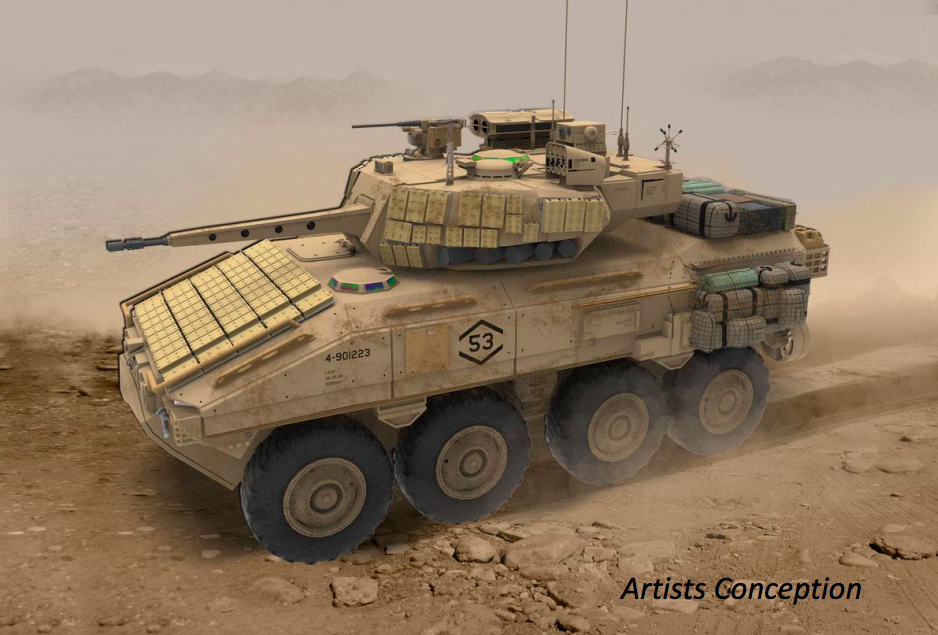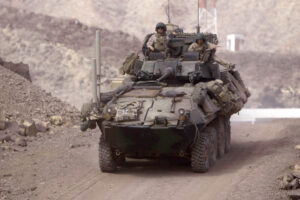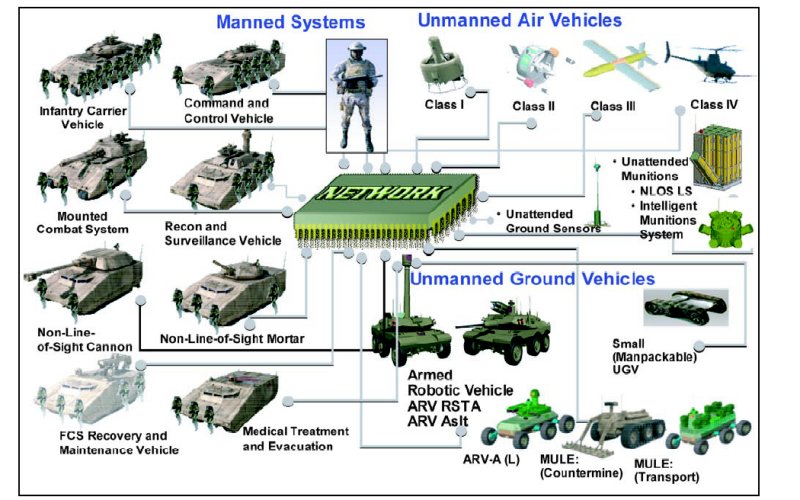
Marine Corps notional depiction of a future Armored Reconnaissance Vehicle (ARV)
WASHINGTON: By 2023, the Marine Corps wants prototypes for a radically new scout unit they want to be the ground version of the F-35 — scouting ahead into hostile territory, killing key targets, and feeding data back to the rest of the force. Though called the Armored Reconnaissance Vehicle, the project has evolved well beyond a straightforward replacement for the aging Light Armored Vehicle (LAV) into a networked family of manned vehicles, ground robots, and drones, collectively capable of not only reconnaissance but also electronic warfare and long-range precision strikes.

Marine Corps LAV-25 recon vehicle. The ARV started as a replacement for the aging LAV before evolving into something much more ambitious.
Industry response has been overwhelming. Interested companies have submitted some 282 white papers and counting, deputy commandant Lt. Gen. Robert Walsh said last week. These aren’t just traditional prime contractors proposing manned vehicles, but a host of smaller companies proposing also unmanned systems, sensors, networks, EW, weapons, and more, Walsh and his staff said. The Office of Naval Research (ONR), which is running the $42 million science, technology, and prototyping effort for the Marines, has actually had to push back deadlines to sort through this embarrassment of riches.
That’s a stark contrast to the Marines’ first stab at the Armored Reconnaissance Vehicle, when a small number of big contractors proposed modest improvements on the 1980s-vintage LAV. “The reason we did this (i.e. reboot the program and work with ONR): I wasn’t seeing the bright ideas coming from industry,” Walsh said.
By contrast, the former fighter pilot said, “I could see it on F-35,” which started in the 1990s as a stealthy strike fighter but has evolved into an electronic/cyber warfare platform that can gather and “fuse” a vast amount of data to guide the rest of the force. Walsh wanted to see the same ferment of new tactics and technologies for ground reconnaissance. Now, by all accounts, he’s getting it.

Marine Corps notional depiction of various Armed Reconnaissance Vehicle (ARV) variants and drones working together
Big Ambitions
The Marines have big ambitions for the ARV. “The vehicle should be able to launch a UAS (Unmanned Aerial System), scout deep, and then use precision fires (and) electronic warfare,” Walsh said last week. Speaking, at the Modular Open Systems Summit, he emphasized the importance of an open architecture design that could be “constantly” upgraded with new technologies as they become available.
What kinds of technologies? His staff and online materials for a January 9 industry day lay out a long wishlist:
- the ability to operate for extended periods with minimal resupply, part of the emerging Army and Marine Corps focus on “distributed operations” where units disperse and keep on the move to avoid presenting easy targets for precision strikes.
- better amphibious performance than the current LAV while remaining as easy to transport on landing craft (four vehicles per LCAC hovercraft).
- an arsenal of medium-caliber automatic cannon (e.g. 30 mm) for lightly armored targets, anti-armor firepower for heavy tanks, long-range missiles (the Israeli Spike) or kamikaze drones (Switchblade) for targets over the horizon, and some means to shoot down enemy drones. (The systems in parentheses were listed in the industry day briefings as examples, not mandates).
- advanced long-range sensors and a secure communications network to share the data they collect, even in the face of enemy jamming and hacking.
- electronic warfare capability to detect, classify, and jam enemy transmissions, to include downing drones by scrambling their control links.
- Active Protection Systems, like the Israeli Trophy APS now being studied by the Army, to shoot down incoming anti-tank warheads before they hit, as well as unspecified counter-IED (Improvised Explosive Device) defenses.
- passenger capacity for scouts who can dismount and fight on foot (the current LAV carries six, but the number for ARV is not yet fixed).
Now, not all of this equipment has to fit on one vehicle. Even the current LAV exists in multiple variants for different missions: armed troop carrier, mobile command post, mortar carrier, anti-tank, anti-aircraft, and so on. The future ARV, likewise, will be the basis of “Next Generation Armored Reconnaissance Family of Vehicles,” the briefing materials say. And those vehicles will be accompanied by multiple types of unmanned air and ground vehicles, including a small (Group 1) recon/kamikaze drone and larger (Group 3) drones for long-range recon and to air-drop mini-robots to scout targets at ground level.
This kind of complex integration of different systems, emphasizing different ways to gather information, is increasingly typical of US defense programs, not just in the Marine Corps. “The general approach reflects a consistent theme across the services, i.e. attempts to leverage modern technologies involving sensors, communications, and information fusing/analysis to make operators more aware of their environment and forces more effective in general,” said Dakota Wood, a retired Marine now with the Heritage Foundation. “Whether that can be done at acceptable cost and in a reasonable period of time remains to be seen.”

Army slide showing the elements of the (later canceled) Future Combat System
Can They Do It?
Can the Marine Corps, the smallest service, pull together all these disparate technologies into a successful program? With its plan for a family of manned vehicles supported by drones and ground robots, all networked together to share data, the Armored Reconnaissance Vehicle sounds a little like the Army’s cancelled Future Combat Systems, which has become a byword for overreach.
ARV looks a lot more likely to succeed, however, said one experienced observer of ground force modernization programs. “It’s much less ambitious than FCS, though, and it will be bought in fairly small numbers,” the source said. The Marines only aim to buy 500 ARVs — plus associated drones and robots — which is a relatively small number for a defense program.
On a technical level, the source said, “a wheeled vehicle is much less ambitious (than a tracked one as in FCS),” and that’s what the Marines will probably build. There are plenty of wheeled armored vehicles available on the market today, including the Army’s 8×8 Stryker, itself the big brother of the Marines’ LAV, in turn a descendant of the Swiss MOWAG Piranha. Italian and Singaporean designs are currently competing for the Marines’ Amphibious Combat Vehicle (ACV, not to be confused with ARV or for that matter AAV). All these vehicles are basically bulletproof boxes capable of being reconfigured for a wide range of missions, so the ARV program doesn’t need to invent some radically new vehicle to carry its capabilities, as FCS tried to.
Likewise, there are a lot of different drones available that can perform the missions called for in the ARV briefing materials. Ground robotics aren’t as advanced, but at least the Marines are only looking at scout bots, rather than armed remote-controlled vehicles as in the Army’s Next Generation Combat Vehicle program.
What’s more, while the Army wants to get its first prototype NGCVs in 2019 (with tests running through 2024), the Marines don’t plan to get prototype ARVs until late 2023 (tests will run through 2025). Low-rate initial production of the first 50 vehicles will run from 2026-2027, at which point the first ARV unit will reach Initial Operational Capability (IOC). Full rate production of the remaining 450 vehicles will run through 2032.

Lt. Gen. Robert Walsh
“Could we go faster? We absolutely could faster if the money was there,” Walsh told reporters. But in the early 2020s, he said, “we’re bringing on ACV, we’re bringing on JLTV. We’ve got to get through those things” before taking on another ground modernization program.
That tentative timeline — still fairly fast as defense procurements go — gives the Marines eight years to work out the technology. What’s more, the plan is to build two sets of tech demonstrators: one using low-risk, off-the-shelf technology wherever possible, one pushing the envelope in quest of a “revolutionary” improvement. Neither prototype will have to carry the full range of capabilities: Instead, Walsh and his staff said, the objective is to develop “80 percent solutions” designed with an open architecture that will allow easy upgrades in the future, both to improve the baseline ARV and to develop new specialized variants.
It’s important to explore a wide range of options and not lock down requirements too early, Walsh said. (By contrast, FCS set precise objectives and only then looked to see if they were possible). “We’re trying to solve the problem of what is reconnaissance (and) counter-reconnaissance in the future,” he said, not simply replace an old vehicle with a new one.
“If we went to the primes today that build vehicles, they would build a certain box for us and say, ‘this is what we can do,'” Walsh told the modular systems conference. “When you open it up to lots of people, you’re going to come up with lots of different ideas.”
Global military spending hits ‘all-time high’ of $2.4 trillion: SIPRI report
The US remains the world’s largest defense spender, outlaying $916 billion last year, a 2.3 percent annual increase, ahead of China in second place, which spent an estimated $296 billion, a 6 percent increase over the same period.



























